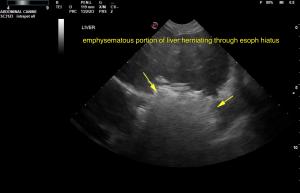Clinical Differential Diagnosis
Leptospirosis
Gall bladder – cholecystitis
Pancreas – acute pancreatitis
Intestinal perforation with regional peritonitis
Sonographic Differential Diagnosis
Emphysematous hepatitis with possible mass formation in the cranial liver with hiatal hernia of the liver lobe.
Possible splenitis or infiltrative disease involving the spleen with regional peritonitis.
Outcome
Aggressive treatment for anaerobic infection is recommended. Adding Clindamycin or Metronidazole would also be recommended for triple antibiotic therapy. Plasma transfusion, plasma expanders and eventual FNA of the spleen and liver would be warranted to rule out underlying neoplasia followed by surgical consultation depending upon follow-up sonogram over the next 48-72 hours. Very guarded prognosis.




